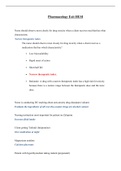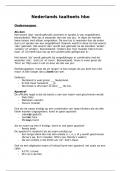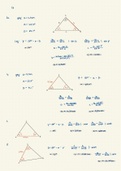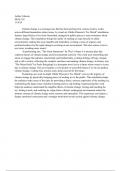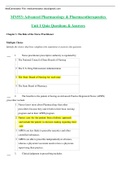Central Control of Endocrine Func<on
Many peripheral hormone systems are controlled by hypothalamus an
base of brain around 3rd ventricle and above pituitary stalk which carr
supply. Contains many vital centres for func@ons, e.g. appe@te and thir
walking. Acts as an integrator of many neural and endocrine inputs to
releasing factors.
Role in circadian rhythm, menstrual cyclicty, responses to stress, exerc
Op<c chiasm: lies just above pituitary fossa - any lesions expanding fro
compress chiasm and cause visual defects.
Suprasellar expansion: upwards expansion of pituitary gland through t
Hypothalamic-Pituitary-Thyroid Axis Hypothalamic Physiology: Hypothalamic neurones secrete pituitary-re
HPT axis required for hormone system control. hormones into portal system, which descends down pituitary stalk to p
TRH: thyrotrophin-releasing hormone; secreted in hypothalamus; travels via portal system to large amounts of other neuropep@des and transmiOers, e.g. Neuropep
pituitary where it s@mulates TSH produc@on by thyrotrophs pituitary func@on.
TSH: thyroid-s@mula@ng hormone; secreted into circula@on; s@mulates increased thyroidal Anterior Pituitary. Hormone secre@on: controlled by hypothalamic rel
iodine uptake and synthesis and release of T3 and T4. TSH also s@mulates peripheral Growth hormone release: s@mulated by GRHR; inhibited by somatosta
conversion of T4 to T3 Release Inhibitory Hormone)
T3 and T4 enter cells, bind to nuclear Rs and promote inc metabolic and cellular ac@vity. T3 TSH: release s@mulated by TRH; par@ally inhibited by somatosta@n
levels sensed by pituitary and hypothalamic Rs. If T3 too high, TRH and TSH synthesis Cor@cotrophin-releasing hormone (CRH) and vasopressin: endogenous
suppressed and T4 and T3 secre@on is reduced. Peripheral T3/T4 levels drop to normal. If T3 Posterior Pituitary: Acts merely as a storage hormone.
and T4 levels too low, increased produc@on and secre@on of TRH and TSH results in thyroid ADH (vasopressin) and oxytocin are synthesised in supra-op@c (SON) a
increasing its produc@on of T3 and T4: restores plasma levels of T3 and T4, however may anterior hypothalamus. They are transported to posterior pituitary (th
occur at expense of TSH (thus get high TSH levels; compensated euthyroidism). alone does not affect produc@on/release of ADH or oxytocin).
Posterior Pituitary Physiology Cranial Diabetes Insipidus:
Water Homeostasis: 400-500mL/day water needed to excrete solute load in maximally Complete/ par@al; Permanent/ temporary
concentrated urine. Intake of 700-800mL/d is needed to match total water losses and remain in All of the pathogenic lesions involve: Supraop@c and paraventricu
water balance. Chronically, inges@ng <700 to 800mL/day à increased osmolality and s@mula@on of Major por@on of the pituitary stalk
thirst. The solute load when excreted in maximally diluted urine approaches 25L Simple destruc@on of posterior pituitary lobe à temporary, unsus
Chronically, inges@ng >25L of water a day à loss of body fluid homeostasis and a lowering of reduced renal concentra@ng capacity
plasma osmolality Primary Cranial DI
Hormones: oxytocin, vasopressin, neurophysin Marked decrease (>90%) in the hypothalamic nuclei of the neuro-
- Oxytocin: No known role in men; may aid contrac@on of seminal vesicles. In women, contracts Gene@c abnormali@es of the AQP-2 gene (AD) on chromosome 20
pregnant uterus and causes breast duct smooth muscle contrac@on, allowing milk ejec@on. No Idiopathic
known adverse effects from deficiency. Associated with DM, op@c atrophy and deafness, atonia of bladde
- Neurophysin: Released with vasopressin. Acts as a carrier protein in neurons to transport Secondary (Acquired) cranial DI
vasopressin to the post-pituitary. Hypophysectomy. Cranial injuries, basal skull fractures. Supra- and
- AVP (arginine vasopressin) [ADH – an@diure@c hormone]: posterior lobe = major site of AVP secondary). Langerhans’ cell-type his@ocytosis (Hand-Schuller-Chr
storage and release, but AVP is synthesized within hypothalamus; Leads to inser@on of water (sarcoidosis or TB). Vascular (aneurysms and thrombosis). Infec@o
channels into the luminal membrane. Allows passive solute-free water reabsorp@on along an
osmo@c gradient from lumen of collec@ng duct to the hypertonic medullary inters@@um. Has a
pressor effect in high concentra@on. Acts synergis@cally with CRH as an ACTH secretagogue. Dipsogenic DI
Cor@sol deficiency results in failure to excrete a water load; can mask cranial DI Compulsive water drinking; associated with affec@ve disorders. Dr
- Placenta contains vasopressinase (pregnancy can worsen syndrome of CDI= cranial DI) hypothalamic disease: sarcoid, tumours involving h ypothalamus;
S<mulants of AVP secre<on: increased osmo@c pressre of body water; volume deple@on; pain, Diagnosis of DI: Suspect if large volumes (3-30L/day) of very dilute
stress, hypoxia, hypoglycemia, emesis, exercise, pregnancy, cholinergic agonists (beta-blockers, osmolality <200mOsm/L) are excreted. All tests for DI are based o
angiotensin and prostaglandins) osmolality in normal person will lead to decreased excre@on of ur
Inhibitors of AVP secre<on: alcohol, alpha-blockers, glucocor@coids Water depriva@on test. Hypertonic saline infusion- AVP measurem
Breakdown of the plasma-osmolality-VP rela<onship: Rapid changes of plasma osmolality: rapid Inves<ga<on: Exclude DM, renal disease, hypercalcaemia, hypoka
increases in plasma osmolality result in exaggerated VP release. During the act of drinking: drinking tumours: hypothalamic, pineal, infiltra@ve; Loss of bright spot of p
rapidly suppresses VP release, through afferent pathways origina@ng in the oropharynx. Pregnancy: (sarcoidosis)
the osmo@c threshold for VP release is lowered in pregnancy. Aging: Plasma VP concentra@ons Tumour markers e.g. beta-HCG (pineal germinoma)
increase with age, together with enhanced VP responses to osmo@c s@mula@on. Age-related Tests for DI: Water depriva@on test – Simplest and most reliable m
changes also include: blun@ng of thirst apprecia@on, reduced Eluid intake, decreased ability to whilst the pa@ent is under constant supervision: in DI, this test ma
excrete a free water load, reduced renal concentra@ng capacity drinkers may be unable to avoid drinking unless prevented from d
• Normal response: Max urinary osmolality aqer dehydra@on (o
Maximum urine osm > plasma osm; Does not increase more a
Syndrome of Inappropriate AVP secre<on (SIAVP) • Pa@ents with DI: Urine does not concentrate > plasma osmola
Less than maximally dilute urine with pI hypo-osmolality and hypo-natraemia by >50% aqer vasopressin.
Relies on the absence of: Volume deple@on/overload; Emo@onal stress or pain; Diure@cs/other • Pa@ents with par@al DI: Concentra@on urine > plasma osmola
drugs s@mula@ng AVP secre@on; Abnormal cardiac, hepa@c, renal, adrenal, thyroid func@on aqer AVP
Causes of SIAVP • Pa@ents with NDI: Do not concentrate urine > plasma osmola
Malignancy: Pulmonary, duodenum, pancreas, lymphoma, CNS to AVP
Pulmonary disorders: Pneumonia, lung abscess, tuberculosis, aspergillosis, posi@ve pressure • Pa@ents with compulsive polydipsia: May have normal respon
breathing show responses similar to that of pa@ents with par@al DI; Sho
CNS disorders: Encephali@s, meningi@s, brain abscess, Guillain-Barre syndrome, subdural or Hypertonic saline infusion AVP measurement
subarachnoid haemorrhage, Acute psychosis, stroke, acute intermiOent porphyria Treatment of DI:
Hypo-osmolal Hyponatramia: • Mild CDI: may not require treatment
Primary sodium loss: secondary water gain; Integumentary loss; GI loss; Renal loss: diure@cs, • Treatment of CDI: desmopressin (Vasopressin anologue ac@n
osmo@c diuresis, hypoaldosteronism, salt-was@ng nephropathy, post-obstruc@ve diuresis; non- intranasally/ perenterally [sc/im/iv])
oliguric acute tubular necrosis • Treatment of NDI: high doses of vasopressin; thiazide diure@c
Primary water gain: secondary Na loss; Primary polydipsia: reduced solute intake (e.g. beer indomethacin; adequate Eluid intake
potomania); AVP release due to pain, nausea, drugs; SIAVP; Glucocor@coid
Many peripheral hormone systems are controlled by hypothalamus an
base of brain around 3rd ventricle and above pituitary stalk which carr
supply. Contains many vital centres for func@ons, e.g. appe@te and thir
walking. Acts as an integrator of many neural and endocrine inputs to
releasing factors.
Role in circadian rhythm, menstrual cyclicty, responses to stress, exerc
Op<c chiasm: lies just above pituitary fossa - any lesions expanding fro
compress chiasm and cause visual defects.
Suprasellar expansion: upwards expansion of pituitary gland through t
Hypothalamic-Pituitary-Thyroid Axis Hypothalamic Physiology: Hypothalamic neurones secrete pituitary-re
HPT axis required for hormone system control. hormones into portal system, which descends down pituitary stalk to p
TRH: thyrotrophin-releasing hormone; secreted in hypothalamus; travels via portal system to large amounts of other neuropep@des and transmiOers, e.g. Neuropep
pituitary where it s@mulates TSH produc@on by thyrotrophs pituitary func@on.
TSH: thyroid-s@mula@ng hormone; secreted into circula@on; s@mulates increased thyroidal Anterior Pituitary. Hormone secre@on: controlled by hypothalamic rel
iodine uptake and synthesis and release of T3 and T4. TSH also s@mulates peripheral Growth hormone release: s@mulated by GRHR; inhibited by somatosta
conversion of T4 to T3 Release Inhibitory Hormone)
T3 and T4 enter cells, bind to nuclear Rs and promote inc metabolic and cellular ac@vity. T3 TSH: release s@mulated by TRH; par@ally inhibited by somatosta@n
levels sensed by pituitary and hypothalamic Rs. If T3 too high, TRH and TSH synthesis Cor@cotrophin-releasing hormone (CRH) and vasopressin: endogenous
suppressed and T4 and T3 secre@on is reduced. Peripheral T3/T4 levels drop to normal. If T3 Posterior Pituitary: Acts merely as a storage hormone.
and T4 levels too low, increased produc@on and secre@on of TRH and TSH results in thyroid ADH (vasopressin) and oxytocin are synthesised in supra-op@c (SON) a
increasing its produc@on of T3 and T4: restores plasma levels of T3 and T4, however may anterior hypothalamus. They are transported to posterior pituitary (th
occur at expense of TSH (thus get high TSH levels; compensated euthyroidism). alone does not affect produc@on/release of ADH or oxytocin).
Posterior Pituitary Physiology Cranial Diabetes Insipidus:
Water Homeostasis: 400-500mL/day water needed to excrete solute load in maximally Complete/ par@al; Permanent/ temporary
concentrated urine. Intake of 700-800mL/d is needed to match total water losses and remain in All of the pathogenic lesions involve: Supraop@c and paraventricu
water balance. Chronically, inges@ng <700 to 800mL/day à increased osmolality and s@mula@on of Major por@on of the pituitary stalk
thirst. The solute load when excreted in maximally diluted urine approaches 25L Simple destruc@on of posterior pituitary lobe à temporary, unsus
Chronically, inges@ng >25L of water a day à loss of body fluid homeostasis and a lowering of reduced renal concentra@ng capacity
plasma osmolality Primary Cranial DI
Hormones: oxytocin, vasopressin, neurophysin Marked decrease (>90%) in the hypothalamic nuclei of the neuro-
- Oxytocin: No known role in men; may aid contrac@on of seminal vesicles. In women, contracts Gene@c abnormali@es of the AQP-2 gene (AD) on chromosome 20
pregnant uterus and causes breast duct smooth muscle contrac@on, allowing milk ejec@on. No Idiopathic
known adverse effects from deficiency. Associated with DM, op@c atrophy and deafness, atonia of bladde
- Neurophysin: Released with vasopressin. Acts as a carrier protein in neurons to transport Secondary (Acquired) cranial DI
vasopressin to the post-pituitary. Hypophysectomy. Cranial injuries, basal skull fractures. Supra- and
- AVP (arginine vasopressin) [ADH – an@diure@c hormone]: posterior lobe = major site of AVP secondary). Langerhans’ cell-type his@ocytosis (Hand-Schuller-Chr
storage and release, but AVP is synthesized within hypothalamus; Leads to inser@on of water (sarcoidosis or TB). Vascular (aneurysms and thrombosis). Infec@o
channels into the luminal membrane. Allows passive solute-free water reabsorp@on along an
osmo@c gradient from lumen of collec@ng duct to the hypertonic medullary inters@@um. Has a
pressor effect in high concentra@on. Acts synergis@cally with CRH as an ACTH secretagogue. Dipsogenic DI
Cor@sol deficiency results in failure to excrete a water load; can mask cranial DI Compulsive water drinking; associated with affec@ve disorders. Dr
- Placenta contains vasopressinase (pregnancy can worsen syndrome of CDI= cranial DI) hypothalamic disease: sarcoid, tumours involving h ypothalamus;
S<mulants of AVP secre<on: increased osmo@c pressre of body water; volume deple@on; pain, Diagnosis of DI: Suspect if large volumes (3-30L/day) of very dilute
stress, hypoxia, hypoglycemia, emesis, exercise, pregnancy, cholinergic agonists (beta-blockers, osmolality <200mOsm/L) are excreted. All tests for DI are based o
angiotensin and prostaglandins) osmolality in normal person will lead to decreased excre@on of ur
Inhibitors of AVP secre<on: alcohol, alpha-blockers, glucocor@coids Water depriva@on test. Hypertonic saline infusion- AVP measurem
Breakdown of the plasma-osmolality-VP rela<onship: Rapid changes of plasma osmolality: rapid Inves<ga<on: Exclude DM, renal disease, hypercalcaemia, hypoka
increases in plasma osmolality result in exaggerated VP release. During the act of drinking: drinking tumours: hypothalamic, pineal, infiltra@ve; Loss of bright spot of p
rapidly suppresses VP release, through afferent pathways origina@ng in the oropharynx. Pregnancy: (sarcoidosis)
the osmo@c threshold for VP release is lowered in pregnancy. Aging: Plasma VP concentra@ons Tumour markers e.g. beta-HCG (pineal germinoma)
increase with age, together with enhanced VP responses to osmo@c s@mula@on. Age-related Tests for DI: Water depriva@on test – Simplest and most reliable m
changes also include: blun@ng of thirst apprecia@on, reduced Eluid intake, decreased ability to whilst the pa@ent is under constant supervision: in DI, this test ma
excrete a free water load, reduced renal concentra@ng capacity drinkers may be unable to avoid drinking unless prevented from d
• Normal response: Max urinary osmolality aqer dehydra@on (o
Maximum urine osm > plasma osm; Does not increase more a
Syndrome of Inappropriate AVP secre<on (SIAVP) • Pa@ents with DI: Urine does not concentrate > plasma osmola
Less than maximally dilute urine with pI hypo-osmolality and hypo-natraemia by >50% aqer vasopressin.
Relies on the absence of: Volume deple@on/overload; Emo@onal stress or pain; Diure@cs/other • Pa@ents with par@al DI: Concentra@on urine > plasma osmola
drugs s@mula@ng AVP secre@on; Abnormal cardiac, hepa@c, renal, adrenal, thyroid func@on aqer AVP
Causes of SIAVP • Pa@ents with NDI: Do not concentrate urine > plasma osmola
Malignancy: Pulmonary, duodenum, pancreas, lymphoma, CNS to AVP
Pulmonary disorders: Pneumonia, lung abscess, tuberculosis, aspergillosis, posi@ve pressure • Pa@ents with compulsive polydipsia: May have normal respon
breathing show responses similar to that of pa@ents with par@al DI; Sho
CNS disorders: Encephali@s, meningi@s, brain abscess, Guillain-Barre syndrome, subdural or Hypertonic saline infusion AVP measurement
subarachnoid haemorrhage, Acute psychosis, stroke, acute intermiOent porphyria Treatment of DI:
Hypo-osmolal Hyponatramia: • Mild CDI: may not require treatment
Primary sodium loss: secondary water gain; Integumentary loss; GI loss; Renal loss: diure@cs, • Treatment of CDI: desmopressin (Vasopressin anologue ac@n
osmo@c diuresis, hypoaldosteronism, salt-was@ng nephropathy, post-obstruc@ve diuresis; non- intranasally/ perenterally [sc/im/iv])
oliguric acute tubular necrosis • Treatment of NDI: high doses of vasopressin; thiazide diure@c
Primary water gain: secondary Na loss; Primary polydipsia: reduced solute intake (e.g. beer indomethacin; adequate Eluid intake
potomania); AVP release due to pain, nausea, drugs; SIAVP; Glucocor@coid


